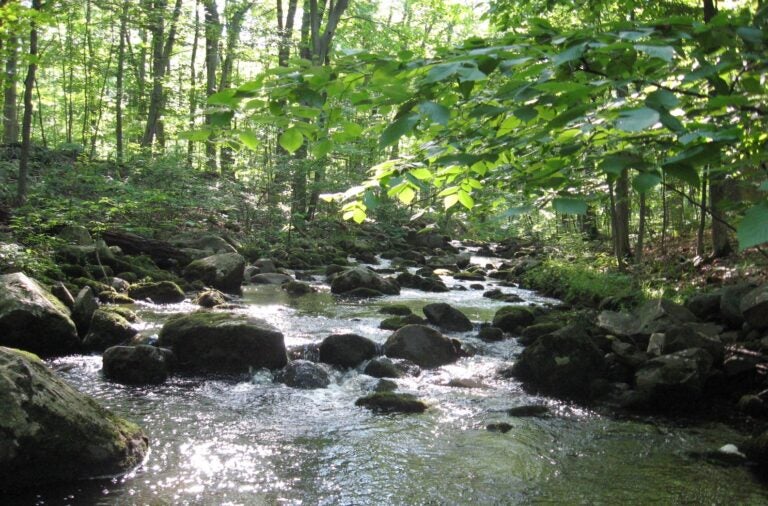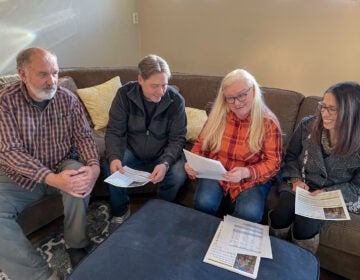Hearing on Upper Bucks quarry moves into developer cross-examination
At a fifth Springfield Twp. hearing, questions spanned everything from truck traffic to wetlands and watershed disturbance, reflecting opponents’ concerns.

Upper Tohickon Creek in Bucks County — the Upper Tohickon Creek watershed includes Springfield, Richland, Haycock, and East Rockhill. (Upper Tohickon Creek Watershed Association)
The fifth hearing on a conditional-use application for a proposed quarry in Springfield Township, Bucks County, brought a first round of cross-examination, pointing toward opposition concerns that could be key stakes in the final decision — and simultaneously indicating that decision may not come quickly or smoothly.
The project up for consideration — a two-pit quarry that would occupy 196 acres of Upper Bucks County wetlands and forest for the next 40 years — has been met with apparently unanimous disapproval from residents, who worry about noise, traffic, and environmental disruption. But local developer H&K Group is pushing the quarry application through, saying that the site is currently zoned for industrial use. Local officials have to make the final call based on whether the project fits within the township’s legal and technical specifications, regardless of residents’ approval.
Because of increased COVID-19 restrictions in December, H&K representatives were allowed to present in person to the township Board of Supervisors while all other interested parties attended virtually. That didn’t fly with township residents, who complained that unequal in-person representation for the developer was unfair. The resulting agreements make subsequent hearings completely virtual, at least until state restrictions are lifted.
With Supervisors James Nilsen, James Hopkins, Anthony Matzura, Bill Ryker, and Raymond Kade presiding, and township solicitor Scott McNair, H&K lawyer Joseph LaFlamme, and more than 40 local residents in virtual attendance, Clean Air Council attorney Alex Bomstein cross-examined H&K project engineer Scott Drumbore for the first time since the hearings began.
Bomstein’s questions, which spanned everything from property value conservation, to noise restrictions, to the potential disturbance of wetlands and water sources, offered a glimpse of the quarry opponents’ main concerns.
He began by asking Drumbore about the zoning code itself and the township’s standard for conditional use, which includes requirements that the project permitted must “conserve the value of the buildings in the vicinity.”
LaFlamme objected to the question, saying interpretation of that section was subjective. Township solicitor McNair overruled the objection and rephrased the question, asking Drumbore if he believed the project would have a negative impact on the conservation of the value of nearby buildings. Drumbore said no, citing a study he conducted on property sales near a former H&K quarry and saying that property values did not drop, that new developments continued, and that landowners continued to occupy the vicinity.
“We’ve seen first- and second- and third-, and in some cases fourth-generation ownership,” Drumbore added.
When questioned about permits still outstanding beyond the township’s conditional use, Drumbore said the project requires approval from the Pennsylvania Department of Environmental Protection, an air quality permit for the processing plant, a National Pollutant Discharge Elimination System permit (for pollutants released into water), and a special exception approval, among others.
When questioned about ecological studies done so far, Drumbore said H&K has done wetland delineation to identify wetlands on the property and has run a Pennsylvania Natural Diversity Inventory “to identify what species we would have to deal with and ID concerns for endangered species.” The developer has not conducted a tree inventory, identified specimen trees on the property, or conducted a wildlife inventory beyond the state diversity inventory.
However, Drumbore said in response to Bomstein’s questioning about wildlife, “We do not believe that our operation will do what you’re suggesting, which is drive away wildlife … We have wildlife within [existing quarry property] where we haven’t advanced into, where woods have not been cleared or disturbed yet … and it’s the same wildlife and ecosystem that you would see in woods where there is no quarry.”
Additional questions covered potential road damage from truck traffic, information about air quality and noise level monitoring, dust suppression, rainwater management, potential wetland drainage, and sediment and erosion control plans.
Bomstein also referred back to a quarry project H&K currently operates in Naceville, Montgomery County: The company, which is responsible for well replacement within 1,000 miles of the mining operation, has replaced over a dozen wells in the vicinity. When asked for an estimate, Drumbore said the developer has resolved 15 to 20 well complaints on that project over the past two or three years.
Bomstein will continue cross-examination of Drumbore at the next hearing, scheduled to take place virtually Feb. 9 at 7:30 p.m. Further cross-examination from interested parties, as well as testimony from residents in close vicinity to the proposed quarry, will follow.
WHYY is your source for fact-based, in-depth journalism and information. As a nonprofit organization, we rely on financial support from readers like you. Please give today.





